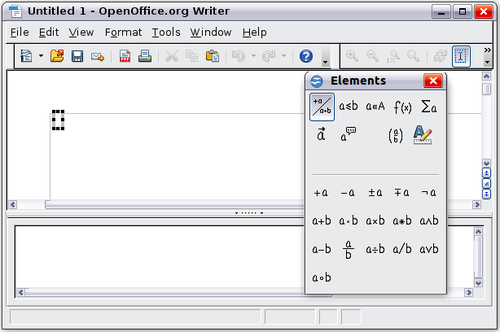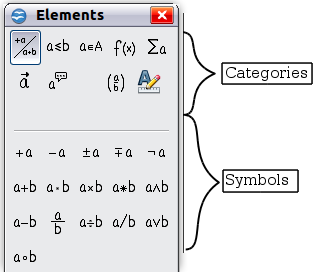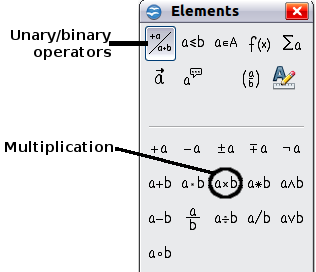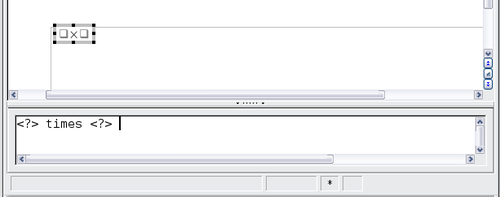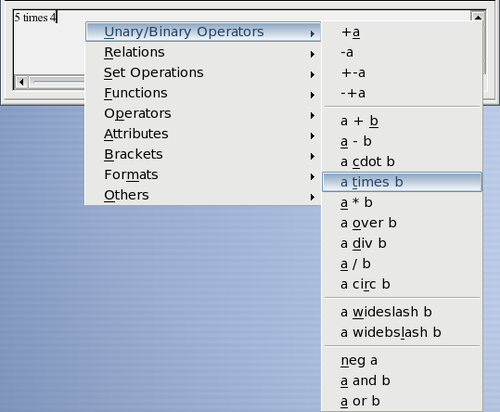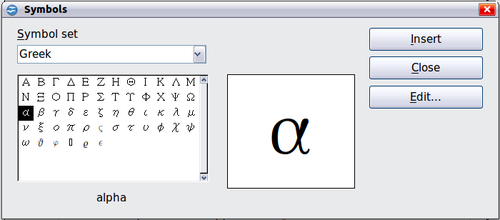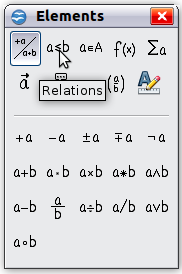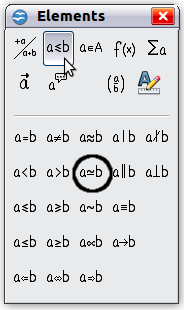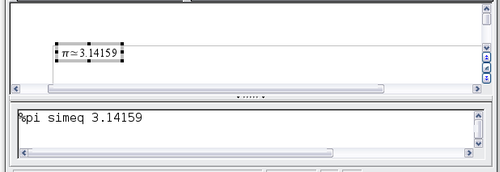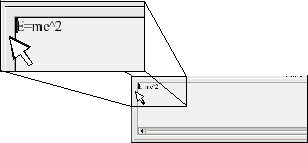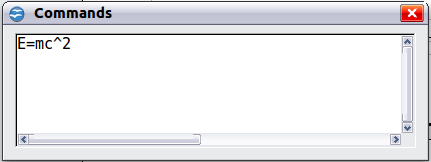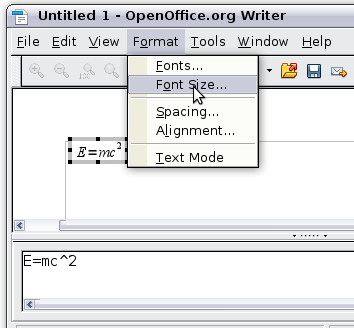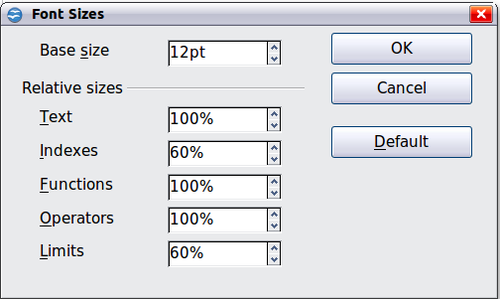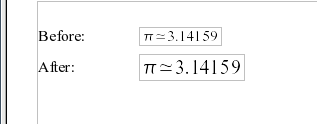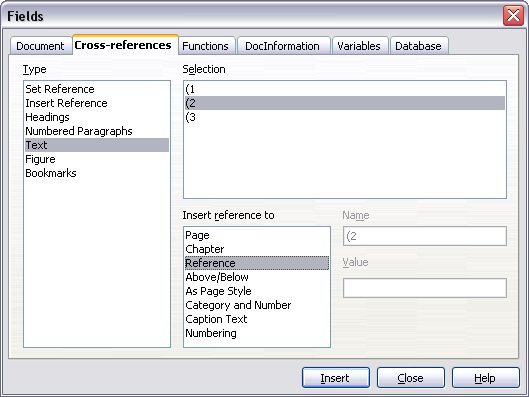Difference between revisions of "Documentation/OOoAuthors User Manual/Writer Guide/Math Objects"
(→Relational operators) |
(→Set operations) |
||
| Line 118: | Line 118: | ||
== Set operations == | == Set operations == | ||
| − | {| | + | {| border="1" |
| − | + | ||'''''Operation'''''||'''''Command'''''||'''''Display'''''|| | |
|- | |- | ||
| − | + | ||Is in||a in B|| | |
|- | |- | ||
| − | + | ||Is not in||a notin B|| | |
|- | |- | ||
| − | + | ||Owns||A owns b|| | |
|- | |- | ||
| − | + | ||Empty set||emptyset|| | |
|- | |- | ||
| − | + | ||Intersection||A intersection B|| | |
|- | |- | ||
| − | + | ||Union||A union B|| | |
|- | |- | ||
| − | + | ||Difference||A setminus B|| | |
|- | |- | ||
| − | + | ||Quotient||A slash B|| | |
|- | |- | ||
| − | + | ||Aleph||aleph|| | |
|- | |- | ||
| − | + | ||Subset||A subset B|| | |
|- | |- | ||
| − | + | ||Subset or equal to||A subseteq B|| | |
|- | |- | ||
| − | + | ||Superset||A supset B|| | |
|- | |- | ||
| − | + | ||Superset or equal to||A supseteq B|| | |
|- | |- | ||
| − | + | ||Not subset||A nsubset B|| | |
|- | |- | ||
| − | + | ||Not subset or equal||A nsubseteq B|| | |
|- | |- | ||
| − | + | ||Not superset||A nsupset B|| | |
|- | |- | ||
| − | + | ||Not superset or equal||A nsupseteq B|| | |
|- | |- | ||
| − | + | ||Set of natural numbers||setN|| | |
|- | |- | ||
| − | + | ||Set of integers||setZ|| | |
|- | |- | ||
| − | + | ||Set of rational numbers||setQ|| | |
|- | |- | ||
| − | + | ||Set of real numbers||setR|| | |
|- | |- | ||
| − | + | ||Set of complex numbers||setC|| | |
|- | |- | ||
|} | |} | ||
| Line 170: | Line 170: | ||
: | : | ||
| − | |||
== Functions == | == Functions == | ||
Revision as of 04:39, 16 September 2007
This page was created by converting ODT to Mediawiki using Writer2MediaWiki. The page needs cleaning up, and figures added.
This is Chapter 16 of the OpenOffice.org 2.x Writer Guide (Third edition), produced by the OOoAuthors group. A PDF of this chapter is available from the OOoAuthors Guides page at OpenOffice.org.
<< User Manuals page
<< Writer Guide Table of Contents
<< Chapter 15 Using Forms in Writer |
Appendix A Keyboard Shortcuts >>
Contents
- 1 Introduction
- 2 Getting started
- 3 The Elements window
- 4 Example 1: 5 × 4
- 5 Right-click menu
- 6 Markup
- 7 Greek characters
- 8 Example 2: π 3.14159
- 9 Formula editor as a floating window
- 10 How can I make a formula bigger?
- 11 Brackets are your friends
- 12 Equations over more than one line
- 13 How do I add limits to my sum/integral?
- 14 Brackets with matrices look ugly!
- 15 How do I make a derivative?
- 16 Numbering equations
- 17 Math commands - Reference
Introduction
OpenOffice.org (OOo) has a component for mathematical equations. It is most commonly used as an equation editor for text documents, but it can also be used with other types of documents or stand-alone. When used inside Writer, the equation is treated as an object inside the text document.
| The equation editor is for writing equations in symbolic form (as in equation 1). If you want to evaluate a numeric value, see the Calc Guide. |
 (1)
(1)
Getting started
To insert an equation, go to Insert > Object > Formula.
The equation editor opens at the bottom of the screen, and the floating Elements window (called “Selection” before Math 3.2 and “Formula Elements” in Math 3.2) may appear. You will also see a small box (with a gray border) in your document, where the formula will be displayed.
The equation editor uses a markup language to represent formulas. For example, %beta creates the Greek character beta (β). This markup is designed to read similar to English whenever possible. For example, a over b produces a fraction: 
To insert a numbered formula in Writer, type fn then press the F3 key.
Additional References
For very basic step-by-step instructions and tutorials for specific tasks, see http://plan-b-for-openoffice.org/math/index
The equation editor uses a markup language to represent formulas. For example, %beta creates the Greek character beta ( ). This markup is designed to read similar to English whenever possible. For example, a over b produces a fraction:
). This markup is designed to read similar to English whenever possible. For example, a over b produces a fraction:  .
.
You can enter a formula in three ways:
- Select a symbol from the Elements window.
- Right-click on the equation editor and select the symbol from the context menu.
- Type markup in the equation editor.
The context menu and the Elements window insert the markup corresponding to a symbol. Incidentally, this provides a convenient way to learn the OOoMath markup.
| Click on the document body to exit the formula editor. Double-click on a formula to enter the formula editor again. |
The Elements window
The simplest method for entering a formula is the Elements window, shown below.
The Elements window is divided into two main portions.
- The top shows the symbol categories. Click on these to change the list of symbols.
- The bottom shows the symbols available in the current category.
Example 1: 5 × 4
For this example we will enter a simple formula: 5 × 4
On the Elements window:
- Select the top-left button of the categories (top) section.
- Click on the multiplication symbol.
When you select the multiplication symbol on the Elements window, two things happen:
- The equation editor shows the markup: <?> times <?>
- The body of the document shows a gray box with the figure:

The <?> symbols are placeholders that you can replace by other text. The equation will update automatically, and the result should resemble the figure below.
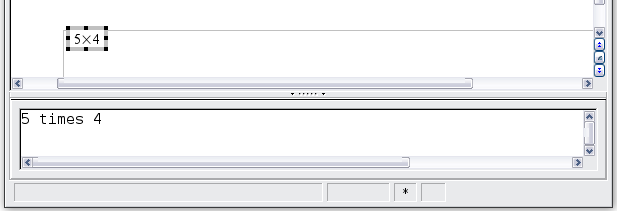
Result of entering "5" and "4" next to the "times" operator.
| To keep the equation from updating automatically, select View > AutoUpdate display. To update a formula manually, press F9 or select View > Update. |
Another way to access mathematical symbols is to right-click on the equation editor. This produces a menu as shown in the figure below.
Markup
You can type the markup directly in the equation editor. For example, you can type “5 times 4" to obtain  . If you know the markup, this can be the fastest way to enter a formula.
. If you know the markup, this can be the fastest way to enter a formula.
Below is a short list of common equations and their corresponding markup.
| Display | Command | Display | Command |
|---|---|---|---|
| a=b | a = b | √a | sqrt {a} |
| a2 | a^2 | an | a_n |
| ∫ f(x)dx | int f(x) dx | ∑ an | sum a_n |
| a≤b | a <= b | ∞ | infinity |
| a×b | a times b | x·y | x cdot y |
Greek characters
Greek characters (α, β, γ, θ, etc.) are common in mathematical formulas. These characters are not available in the Elements window or the right-click menu. Fortunately, the markup for Greek characters is simple: Type a % sign followed the name of the character, in English.
- To type a lowercase character, write the name of the character in lowercase.
- To type an uppercase character, write the name of the character in uppercase.
See the table below for some examples.
| Lowercase | Uppercase |
|---|---|
| %alpha α | %ALPHA Α |
| %beta β | %BETA Β |
| %gamma γ | %GAMMA Γ |
| %psi ψ | %PSI Ψ |
| %phi φ | %PHI Φ |
| %theta θ | %THETA Θ |
| A complete table of Greek characters is included at the end of the Reference section. |
Another way to enter Greek characters is by using the catalog window. Go to Tools > Catalog. The catalog window is shown below. Under “Symbol Set" select “Greek" and double-click on a Greek letter from the list. The markup name of the character is shown below the list window.
Example 2: π  3.14159
3.14159
For this example we will suppose that:
- We want to enter the above formula (the value of pi rounded to 5 decimal places).
- We know the name of the Greek character ("pi").
- But we do not know the markup associated with the
 symbol.
symbol.
Step 1: Type % followed by the text pi. This displays the Greek character π.
Step 2: Open the Elements window (View > Elements).
Step 3: The  symbol is a relation, so we click on the relations button
symbol is a relation, so we click on the relations button ![]() . If you hover the mouse over this button you see the tooltip "Relations".
. If you hover the mouse over this button you see the tooltip "Relations".
Step 4: Click on the  symbol. The equation editor now shows the markup %pi<?> simeq <?>.
symbol. The equation editor now shows the markup %pi<?> simeq <?>.
Step 5: Delete the <?> text and add 3.14159 at the end of the equation. Hence we end up with the markup %pi simeq 3.14159. The result is shown below.
Formula editor as a floating window
As seen in Figure 1, the formula editor can cover a large part of the Writer window. To turn the formula editor into a floating window, do this:
- Hover the mouse over the editor frame, as shown below.
- Hold down the Control key and double-click.
The figure below shows the result. You can make the floating window back into an embedded frame, using the same steps. Hold down the Control key and double-click the window frame.
How can I make a formula bigger?
This is one of the most common questions people ask about OOoMath. The answer is simple, but not intuitive:
- Start the formula editor and go to Format > Font size.
- Select a larger font size under “Base Size" (top-most entry), as shown below.
Edit "Base size" (top) to make a formula bigger.
The result of this change is illustrated below.
The most difficult part of using OOo Math comes when writing complicated formulas. This section provides some advice.
Brackets are your friends
OOo Math knows nothing about order of operation. You must use brackets to state the order of operations explicitly. Consider the following example:
| Markup | Result |
|---|---|
| 2 over x + 1 | 
|
| 2 over {x + 1} | 
|
Equations over more than one line
Suppose you want to type an equation covering more than one line. For example:


Your first reaction would be to simply press the Enter key. However, if you press the Enter key, though the markup goes to a new line, the resulting equation does not. You must type the newline command explicitly. This is illustrated in the table below.
| Markup | Result |
|---|---|
| x = 3 y = 1 |

|
| x = 3 newline y = 1 |

|
See Also
How do I add limits to my sum/integral?
The “sum" and “int" commands can (optionally) take in the parameters “from" and “to". These are used for lower and upper limits respectively. These parameters can be used singly or together. Limits for integrals are usually treated as subscripts and superscripts.
| Markup | Result |
|---|---|
| sum from k = 1 to n a_k |

|
| int from 0 to x f(t) dt or int_0^x f(t) dt |
 or or 
|
| int from Re f | 
|
| sum to infinity 2^{-n} | 
|
| For more details on integrals and sums, see the Math commands reference. |
Brackets with matrices look ugly!
For background, we start with an overview of the matrix command:
| Markup | Result |
|---|---|
| matrix { a # b ## c # d } | 
|
The first problem people have with matrices is that brackets do not “scale" with the matrix:
| Markup | Result |
|---|---|
| ( matrix { a # b ## c # d } ) | ( ) )
|
OOoMath provides “scalable" brackets. That is, the brackets grow in size to match the size of their contents. Use the commands left( and right) to make scalable brackets.
| Markup | Result |
|---|---|
| left( matrix { a # b ## c # d } right) | 
|
How do I make a derivative?
Making derivatives essentially comes down to one trick: Tell OOo it's a fraction.
In other words, you have to use the over command. Combine this with either the letter “d" (for a total derivative) or the partial command (for a partial derivative) to achieve the effect of a derivative.
| Markup | Result |
|---|---|
| {df} over {dx} | 
|
| {partial f} over {partial y} | 
|
| {partial^2 f} over {partial t^2} | 
|
Numbering equations
Equation numbering is one of OOoMath's best hidden features. The steps are simple, but obscure:
- Start a new line.
- Type “fn" and then press F3.
The “fn" is replaced by a numbered formula:
 (2)
(2)
Now you can double-click on the formula to edit it. For example, here is the Riemann Zeta function:
 (3)
(3)
You can reference an equation (“as shown in Equation (2)") with these steps:
- Insert > Cross-reference..
- Click on the References tab (Figure 15).
- Under Type, select Text.
- Under Selection, pick the equation number.
- Under Format, choose Reference.
- Click Insert.
Done! If you later add more equations to the paper before the referenced equation, all the equations will automatically renumber and the cross-references will update.
| To insert the equation number without parenthesis around it, choose Numbering under Format instead of Reference. |
Math commands - Reference
Unary / binary operators
| Operation | Command | Display |
| +sign | +1 | +1 |
| -sign | -1 | −1 |
| +/- sign | +-1 | ±1 |
| -/+ sign | -+1 | inline:Object42.png |
| Boolean not | neg a | ¬a |
| Addition + | a + b | a+b |
| Multiplication dot | a cdot b | a·b |
| Multiplication (X) | a times b | a×b |
| Multiplication (*) | a * b | inline:Object47.png |
| Boolean and | a and b | a∧b |
| Subtraction (-) | a - b | a−b |
| Division (fraction) | a over b | inline:Object294.png |
| Division (operand) | a div b | a÷b |
| Division (slash) | a / b | a/b |
| Boolean or | a or b | a∨b |
| Concatenate | a circ b | inline:Object298.png |
Relational operators
| Operation | Command | Display |
| Is equal | a = b | a=b |
| Is not equal | a <> b | a≠b |
| Approximately | a approx 2 | a≈b |
| Divides | a divides b | |
| Does not divide | a ndivides b | |
| Less than | a < 2 | a<b |
| Greater than | a > 2 | a>b |
| Similar to or equal | a simeq b | |
| Parallel | a parallel b | |
| Orthogonal to | a ortho b | |
| Less than or equal to | a leslant b | |
| Greater than or equal to | a geslant b | |
| Similar to | a sim b | |
| Congruent | a equiv b | a≡b |
| Less than or equal to | a <= b | a≤b |
| Greater than or equal to | a >= b | a≥b |
| Proportional | a prop b | |
| Toward | a toward b | a→b |
| Arrow left | a dlarrow b | a⇐b |
| Double arrow left and right | a dlrarrow b | a⇔b |
| Arrow right | a drarrow b | a⇒b |
Set operations
| Operation | Command | Display | |
| Is in | a in B | ||
| Is not in | a notin B | ||
| Owns | A owns b | ||
| Empty set | emptyset | ||
| Intersection | A intersection B | ||
| Union | A union B | ||
| Difference | A setminus B | ||
| Quotient | A slash B | ||
| Aleph | aleph | ||
| Subset | A subset B | ||
| Subset or equal to | A subseteq B | ||
| Superset | A supset B | ||
| Superset or equal to | A supseteq B | ||
| Not subset | A nsubset B | ||
| Not subset or equal | A nsubseteq B | ||
| Not superset | A nsupset B | ||
| Not superset or equal | A nsupseteq B | ||
| Set of natural numbers | setN | ||
| Set of integers | setZ | ||
| Set of rational numbers | setQ | ||
| Set of real numbers | setR | ||
| Set of complex numbers | setC |
Functions
| Operation | Command | Display | ||
| Exponential | func e^{a} | inline:Object114.png | ||
| Natural logarithm | ln(a) | inline:Object115.png | ||
| Exponential function | exp(a) | inline:Object116.png | ||
| Logarithm | log(a) | inline:Object117.png | ||
| Power | a^{b} | inline:Object118.png | ||
| Sine | sin(a) | inline:Object119.png | ||
| Cosine | cos(a) | inline:Object120.png | ||
| Tangent | tan(a) | inline:Object121.png | ||
| Cotangent | cot(a) | inline:Object122.png | ||
| Square root | sqrt{a} | inline:Object123.png | ||
| Arcsine | arcsin(a) | inline:Object124.png | ||
| Arc cosine | arccos(a) | inline:Object125.png | ||
| Arctangent | arctan(a) | inline:Object126.png | ||
| Arc cotangent | arccot(a) | inline:Object127.png | ||
| nth root | nroot{a}{b} | inline:Object128.png | ||
| Hyperbolic sine | sinh(a) | inline:Object129.png | ||
| Hyperbolic cosine | cosh(a) | inline:Object130.png | ||
| Hyperbolic tangent | tanh(a) | inline:Object131.png | ||
| Hyperbolic cotangent | coth(a) | inline:Object132.png | ||
| Absolute value | abs{a} | inline:Object133.png | ||
| Arc hyperbolic sine | arsinh(a) | inline:Object134.png | ||
| Arc hyperbolic cosine | arccosh(a) | inline:Object135.png | ||
| Arc hyperbolic tangent | arctanh(a) | inline:Object136.png | ||
| Arc hyperbolic cotangent | arccoth(a) | inline:Object137.png | ||
| Factorial | fact{a} | inline:Object138.png |
Operators
- All operators can be used with the limit functions (“from" and “to").
| Operation | Command | Display | ||
| Limit | lim{a} | inline:Object139.png | ||
| Sum | sum{a} | inline:Object140.png | ||
| Product | prod{a} | inline:Object141.png | ||
| Coproduct | coprod{a} | inline:Object142.png | ||
| Upper and lower bounds shown with integral | int from {r_0} to {r_t} a | inline:Object143.png | ||
| Integral | int{a} | inline:Object144.png | ||
| Double integral | iint{a} | inline:Object145.png | ||
| Triple integral | iiint{a} | inline:Object146.png | ||
| Lower bound shown with summation symbol | sum from{3}b | inline:Object147.png | ||
| Contour integral | lint a | inline:Object148.png | ||
| Double curved integral | llint a | inline:Object149.png | ||
| Triple curved integral | lllint a | inline:Object150.png | ||
| Upper bound shown with product symbol | prod to{3} r | inline:Object151.png |
Attributes
| Operation | Command | Display | ||
| Acute accent | acute a | inline:Object111.png | ||
| Grave accent | grave a | inline:Object152.png | ||
| Reverse circumflex | check a | inline:Object153.png | ||
| Breve | breve a | inline:Object154.png | ||
| Circle | circle a | inline:Object155.png | ||
| Vector arrow | vec a | inline:Object156.png | ||
| Tilde | tilde a | inline:Object157.png | ||
| Circumflex | hat a | inline:Object158.png | ||
| Line above | bar a | inline:Object159.png | ||
| Dot | dot a | inline:Object160.png | ||
| Wide vector arrow | widevec abc | inline:Object161.png | ||
| Wide tilde | widetilde abc | inline:Object162.png | ||
| Wide circumflex | widehat abc | inline:Object163.png | ||
| Double dot | ddot a | inline:Object164.png | ||
| Line over | overline abc | inline:Object165.png | ||
| Line under | underline abc | inline:Object166.png | ||
| Line through | overstrike abc | inline:Object167.png | ||
| Triple dot | dddot a | inline:Object168.png | ||
| Transparent (useful to get a placeholder of a given size) | phantom a | inline:Object169.png | ||
| Bold font | bold a | inline:Object170.png | ||
| Italic fontFootNote(Unquoted text that is not a command is considered to be a variable. Variables are, by default, italicized.) | ital “a" | inline:Object171.png | ||
| Resize font | size 16 qv | inline:Object172.png | ||
| Following item in sans serif fontFootNote(There are three custom fonts: sans serif (without kicks), serifs (with kicks), and fixed (non-proportional). To change the actual fonts used for custom fonts and the fonts used for variables (unquoted text), numbers and functions, use Format > Fonts.) | font sans qv | inline:Object173.png | ||
| Following item in serif font | font serif qv | inline:Object174.png | ||
| Following item in fixed font | font fixed qv | inline:Object175.png | ||
| Make color of following text cyanFootNote(For all coloring, the color will apply only to the text immediately following the command until the next space is encountered. In order to have the color apply to more characters, place the text you want in color in curly brackets.) | color cyan qv | inline:Object176.png | ||
| Make color of following text yellow | color yellow qv | inline:Object177.png | ||
| Make color of following text white | color white qv | inline:Object178.png | ||
| Make color of following text green | color green qv | inline:Object179.png | ||
| Make color of following text blue | color blue qv | inline:Object180.png | ||
| Make color of following text red | color red qv | inline:Object181.png | ||
| Make color green returns to default color black | color green X qv | inline:Object182.png | ||
| Brace items to change color of more than one item | color green {X qv} | inline:Object207.png |
Miscellaneous
| Operation | Command | Display | ||
| Infinity | infinity | inline:Object48.png | ||
| Partial | partial | inline:Object49.png | ||
| Nabla | nabla | inline:Object50.png | ||
| There exists | exists | inline:Object54.png | ||
| For all | forall | inline:Object55.png | ||
| H bar | hbar | inline:Object56.png | ||
| Lambda bar | lambdabar | inline:Object60.png | ||
| Real part | re | inline:Object61.png | ||
| Imaginary part | im | inline:Object62.png | ||
| Weierstrass p | wp | inline:Object63.png | ||
| Left arrow | leftarrow | inline:Object64.png | ||
| Right arrow | rightarrow | inline:Object183.png | ||
| Up arrow | uparrow | inline:Object184.png | ||
| Down arrow | downarrow | inline:Object185.png | ||
| Dots at bottom | dotslow | inline:Object186.png | ||
| Dots at middle | dotsaxis | inline:Object187.png | ||
| Dots vertical | dotsvert | inline:Object188.png | ||
| Dots diagonal upward | dotsup | inline:Object189.png | ||
| Dots diagonal downward | dotsdown | inline:Object190.png |
Brackets
| Operation | Command | Display | ||
| Round Brackets | (a) | inline:Object191.png | ||
| Square Brackets | [b] | inline:Object192.png | ||
| Double Square Brackets | ldbracket c rdbracket | inline:Object193.png | ||
| Single line | lline a rline | inline:Object194.png | ||
| Double line | ldline a rdline | inline:Object195.png | ||
| Braces | lbrace w rbrace | inline:Object196.png | ||
| Angle Brackets | langle d rangle | inline:Object197.png | ||
| Operator Brackets | langle a mline b rangle | inline:Object198.png | ||
| Group brackets (used for program control) | {a} | inline:Object199.png | ||
| Scalable round brackets (add the word “left before a left bracket and “right" before a right bracket) |
left ( stack{a # b # z} right ) | inline:Object200.png | ||
| Square brackets scalable (as above) |
left [ stack{ x # y} right ] | inline:Object201.png | ||
| Double square brackets scalable | left ldbracket c right rdbracket | inline:Object202.png | ||
| Line scalable | left lline a right rline | inline:Object203.png | ||
| Double line scalable | left ldline d right rdline | inline:Object204.png | ||
| Brace scalable | left lbrace e right rbrace | inline:Object205.png | ||
| Angle bracket scalable | left langle f right rangle | inline:Object206.png | ||
| Operator brackets scalable | left langle g mline h right rangle | inline:Object208.png | ||
| Over brace scalable | {The brace is above} overbrace a | inline:Object209.png | ||
| Under brace scalable | {the brace is below}underbrace {f} | inline:Object210.png |
Formats
| Operation | Command | Display | ||
| Left superscript | a lsup{b} | inline:Object65.png | ||
| Center superscript | a csup{b} | inline:Object66.png | ||
| Right superscript | a^{b} | inline:Object67.png | ||
| Left subscript | a lsub{b} | inline:Object211.png | ||
| Center subscript | a csub{b} | inline:Object212.png | ||
| Right subscript | a_{b} | inline:Object213.png | ||
| Align character to left (text is aligned center by default) | stack { Hello world # alignl (a) } |
inline:Object220.png | ||
| Align character to center | stack{Hello world # alignc(a)} | inline:Object221.png | ||
| Align character to right | stack { Hello world # alignr(a)} | inline:Object222.png | ||
| Vertical stack of 2 | binom{a}{b} | inline:Object223.png | ||
| Vertical stack, more than 2 | stack{a # b # z} | inline:Object224.png | ||
| Matrix stack | matrix{a # b ## c # d} | inline:Object225.png | ||
| Common mathematical arrangement | matrix{a # "="b ## {} # "="c} | inline:Object226.png | ||
| New line | asldkfjo newline sadkfj | inline:Object227.png | ||
| Small gap (grave) | stuff `stuff | inline:Object228.png | ||
| Large gap (tilde) | stuff~stuff | inline:Object229.png |
Characters – Greek
| %ALPHA | inline:Object68.png | %BETA | inline:Object214.png | %CHI | inline:Object215.png | %DELTA | inline:Object216.png | %EPSILON | inline:Object230.png | ||
| %ETA | inline:Object231.png | %GAMMA | inline:Object232.png | %IOTA | inline:Object233.png | %KAPPA | inline:Object234.png | %LAMBDA | inline:Object235.png | ||
| %MU | inline:Object236.png | %NU | inline:Object237.png | %OMEGA | inline:Object238.png | %OMICRON | inline:Object239.png | %PHI | inline:Object240.png | ||
| %PI | inline:Object241.png | %PSI | inline:Object242.png | %RHO | inline:Object243.png | %SIGMA | inline:Object244.png | %THETA | inline:Object245.png | ||
| %UPSILON | inline:Object246.png | %XI | inline:Object247.png | %ZETA | inline:Object248.png | ||||||
| %alpha | inline:Object249.png | %beta | inline:Object250.png | %chi | inline:Object251.png | %delta | inline:Object252.png | %epsilon | inline:Object253.png | ||
| %eta | inline:Object254.png | %gamma | inline:Object255.png | %iota | inline:Object256.png | %kappa | inline:Object257.png | %lambda | inline:Object258.png | ||
| %mu | inline:Object259.png | %nu | inline:Object260.png | %omega | inline:Object261.png | %omicron | inline:Object262.png | %phi | inline:Object263.png | ||
| %pi | inline:Object276.png | %rho | inline:Object284.png | %sigma | inline:Object285.png | %tau | inline:Object286.png | %theta | inline:Object287.png | ||
| %upsilon | inline:Object288.png | %varepsilon | inline:Object289.png | %varphi | inline:Object290.png | %varpi | inline:Object291.png | %varrho | inline:Object299.png | ||
| %varsigma | inline:Object300.png | %vartheta | inline:Object301.png | %xi | inline:Object302.png | %zeta | inline:Object303.png |
Characters – Special
| %and inline:Object344.png | %angle inline:Object272.png | %element inline:Object273.png | %identical inline:Object274.png | ||
| %infinite inline:Object275.png | %noelement inline:Object345.png | %notequal inline:Object346.png | %or inline:Object347.png | ||
| %perthousand inline:Object348.png | %strictlygreaterthan inline:Object349.png | %strictlylessthan inline:Object350.png | %tendto inline:Object351.png |
| Content on this page is licensed under the Creative Common Attribution 3.0 license (CC-BY). |

